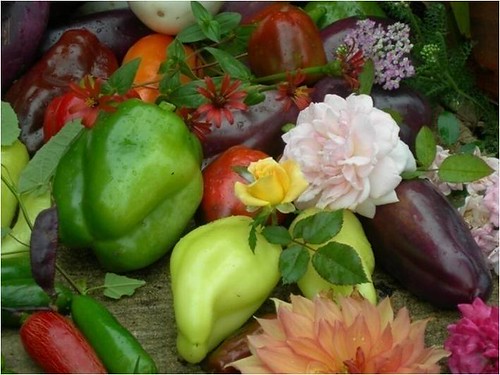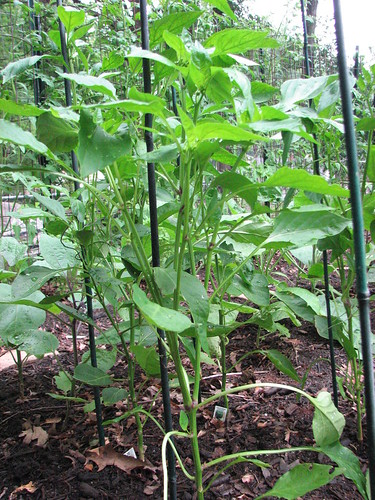How to Get Peppers off to a Good Start (w/More Fruit that Ripens Faster)
Peppers can be very easy to grow but many gardeners struggle with productivity, sun scald, or getting those darned red ones to ripen. A few simple tricks can make a big difference in getting a successful harvest.

Photo Caption: Sometimes it is hard to wait until peppers are fully ripe... those first ones tease us with slight blushes for weeks! It turns out peppers won't ripen well until the plants are mature and loaded with leaves, so just eat the early ones green. Don't worry, you'll get great ripe ones in the fall!
The most important first step, whether you grow from seed or buy transplants, is to get started with sturdy, healthy seedlings.
If you are choosing transplants from a nursery you want them to look like they are in the climax of a growth spurt. This is hard to describe, and experience helps, but the plant stems and leaves should look supple and fresh due to rapid new growth. Short, stocky plants are good unless the stem looks stiff and woody, which may indicate it is stunted. In that case pop the plant out of the pot and see if it is root bound. Likewise, taller growth (around 8″) can point to a healthy seedling, but it can also mean too much time spent in its tiny pot. Watch out for top-heavy plants that fall over, and again check for young growth instead of tough plant tissue and bound rootballs. Both types of seedlings can be water stressed if they have resided at a neglectful nursery. Plants with crispy leaf edges or bald patches are not good choices.
And here’s the kicker: Don’t buy that plant with the peppers already on it! No! Walk away! I don’t care how tempting it is — that sad, stunted little fruit weighing the transplant to the ground like a Charlie Brown Christmas tree is not a sign that you’ll have a head-start in your garden. It’s the opposite! Ideally you should pick transplants that have no flowers on them whatsoever but that can be impossible to find since peppers are so eager to bloom. At least try to pick plants that only have young buds and then pinch them off!!! C’mon, bring on the tough love! Your plants will thank you with bumper yields.
If you are starting your peppers from seed make sure you are starting with fresh seed. I’m a seed saver and I tend to push the limits of when different species are supposed to be viable but I’ve found that even when I can get older pepper seeds to germinate they usually have reduced vigor. I have started replacing my seeds when they are 2 years old.
Additionally, you may not want to follow the instructions on the packet. It depends on where you live and what kind of growing setup you have. If you have a greenhouse or a quality grow light setup you can go ahead and start the recommended 7 – 10 weeks before your planting date. If not, cut down to about 6 – 9 weeks before your plant date (and put the trays somewhere warm until they germinate, like on top of a refrigerator or seed heating mat). Most sunny windows just don’t give veggie seedlings the amount of light that they need. If you start later your seedlings won’t have time to get tall and leggy before you put them outside. It’s better to plant out a sturdy 4″ transplant that is still growing rapidly than it is to plant an anemic, stressed out 8″ pepper that promptly flops over onto its side.
Peppers, both young and old, don’t like irrigation extremes. Too dry or too wet will stress your seedlings and stop the rapid growth that you want to see. Don’t let the pots sit in puddles of water! Ideally your soil should feel slightly damp, like a wrung-out sponge.
Another great trick for light-challenged gardeners trying to start transplants from seed is to take your trays outside on warm days and bring them in at night. Make sure it really is warm, peppers don’t grow well in the cold.
Which brings me to your planting out date. Peppers prefer warmer spring soil and they don’t grow much until this happens. You aren’t getting a head start if you plant them out the very day your frost-free date arrives. They’ll just sit there and pout. Plan to plant them out about 2 weeks after your frost free date (unless you live in an area with very short summers) and you’ll have much better results.

Photo Caption: This pepper plant is large and leafy enough at the top to start supporting fat peppers.
Now that you have your robust seedlings safely in your garden beds (which of course are full of rich, loamy, well-irrigated soil) you need to get back to hardening your soul against early flowering. I spend the first month that peppers are in the garden pinching off buds left and right. There are a few reasons to do this. First, you want your pepper spending its energy on a good root system to support the top part of the plant. Next, you want stocky plants with ample leaf coverage so the plant doesn’t flop over or allow the future fruits to get sun scalded. Lastly, you want lots of leafy growth so that your plants have the energy to support a big crop! More leaves means more sugars produced by your plant… which is how you get nice, ripe, colorful peppers.
Small-fruited peppers need fewer leaves to ripen than large varieties. That means those big bells you are craving will be the longest wait. If you’ve ever hovered over a few green peppers endlessly hoping they will change colors you know what I mean. Sometimes they even get sunscald and rot… a sure sign your plant didn’t have enough photosynthetic energy to go the extra mile. The solution is to not wait! Just eat those early peppers while they are green and plan to pick the extra sweet and ripe ones when your plants are bigger in the fall.
It takes some early self-denial and patience, but it pays off. I usually stop pinching off the flower buds once the plant reaches about 14″ tall. By the end of the season they are about 2′ wide x 3′ high and loaded with fruits.
It’s a good idea to mulch because peppers don’t like water fluctuations and they can be prone to splash diseases which mulching can reduce. If your garden is prone to getting sick you should choose disease resistant varieties.
Fertility is also important, both for good fruit set and for the prevention of blossom end rot. I use my own recipe for organic slow release fertilizer but you can also buy a fertilizer formulated for vegetable production. Make sure you get your transplants to a fast start by fertilizing at the recommended dose when you put them in the garden and then following package instructions for the remainder of the season. If you are using my recipe you can give them an extra feeding once every month or two.
The above care practices should get any pepper to fruit well for you unless you have a short growing season. If you are impatient for those red sweet ones you can choose pepper varieties with a shorter maturity time. Peppers that start creamy yellow and ripen to red tend to be faster than peppers that start out green. Smaller peppers also ripen faster than large ones. Some varieties to consider include:
- ‘Gypsy’
- ‘Antohi Romanian’
- ‘Healthy’
- ‘Cherry Pick’
- any paprika type (slightly warm)
- any sweet banana type (some can be warm)
I’ve grown all the ones linked here and can recommend them highly.
Lastly, don’t give up. Those of us with hot summers often have to just deal with lower pepper production for a chunk of the season — they hate to be too hot and will drop their blooms. Don’t worry! Your plants will make up for it when the weather begins to cool back off. My best pepper harvests are always in October.
Those of you who are fellow nightshade addicts may also enjoy How to Grow Eggplants Faster than the Flea Beetles Can Kill Them.
5 thoughts on “How to Get Peppers off to a Good Start (w/More Fruit that Ripens Faster)”
Comments are closed.

Liza - February 18, 2010 12:42 pm
Great information – nice work!
Sustainahillbilly
Twitter: appalachianfeet
- February 18, 2010 6:36 pm
Thanks!
Pingback: How to Grow Vegetables (Archive Directory) | Appalachian Feet
Pingback: How to Select Hot Pepper Varieties (& Use the Ones You Grow) | Appalachian Feet
Pingback: How to Set Garden Goals & Go to the Organic Growers School | Appalachian Feet